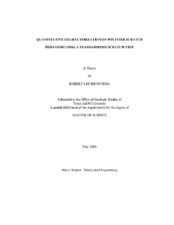| dc.description.abstract | The lack of a widely-accepted quantitative methodology for evaluating the
scratch behavior of polymeric materials has resulted in the development and
establishment of a new methodology recently standardized as ASTM D7027-05. Using
a custom-built instrumented scratch machine, it is possible to produce controlled,
repeatable scratches on polymer surfaces under constant or linearly increasing loading
conditions at constant or increasing scratch rates. Software-aided digital image analysis
along with material science tools (SEM, OM, FTIR, etc.) allows polymer scratch
behavior to be analyzed without the ambiguity inherent in the past.
The current work will serve to describe the motivation for the development of
this methodology as well as illustrate the effectiveness of the increasing load/constant
rate test mode in three case studies. First, it will be shown that an acrylic coating on a
steel system exhibits three zones of scratch damage: adhesive delamination, transverse
cracking and finally buckling failure. It will be discussed how increases in ductility and
thickness serve to improve the scratch resistantance of this coating/substrate system.
Improvements in the scratch behavior of thermoplastic olefins (TPOs) through the use of surface-treated talc fillers and the slip agent erucamide will be shown in the second case.
It was found that the surface-treatment of the talc likely allows for enhanced migration
of the erucamide to the TPO surface, thus lowering the surface friction and greatly
increasing scratch resistance. Finally, the effects of processing conditions, namely
injection molding, on the scratch behavior of neat i-polypropylene will be represented by
the results of scratch tests conducted where the scratch direction was oriented both along
and transverse to the polymer melt flow direction. Based on the findings of the study,
there appears to be a high degree of surface anisotropy introduced to injection-molded
polymers due to complex fluid flow regimes as well as non-uniform cooling properties. | en |


